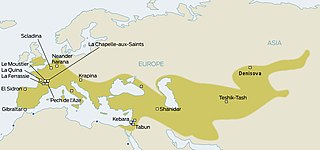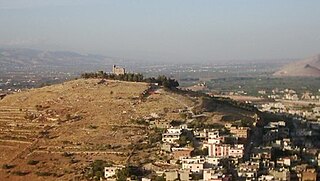Related Research Articles

The Mousterian is an archaeological industry of stone tools, associated primarily with the Neanderthals in Europe, and to the earliest anatomically modern humans in North Africa and West Asia. The Mousterian largely defines the latter part of the Middle Paleolithic, the middle of the West Eurasian Old Stone Age. It lasted roughly from 160,000 to 40,000 BP. If its predecessor, known as Levallois or Levallois-Mousterian, is included, the range is extended to as early as c. 300,000–200,000 BP. The main following period is the Aurignacian of Homo sapiens.

Saint Joseph University of Beirut is a private Catholic research university located in Beirut, Lebanon, which was founded in 1875 by French Jesuit missionaries. It is regarded among the top and most reputable academic institutions in Lebanon and the Middle East. Its alumni include numerous Lebanese presidents, ministers, judges, lawyers, philosophers, writers, scientists, intellectuals, artists, clerics and beyond. As Lebanon's oldest and main French university, it promotes Lebanese culture while openly disregarding ethno-religious affiliations during admissions and encourages a trilingual teaching of French, Arabic and English. Additionally, it is known in Lebanon and the Middle East for its university hospital, the Hôtel-Dieu de France, and for its prestigious and historical Faculty of Law, modern Lebanon's oldest law school and the first law school in Lebanon since the ancient Roman law school of Berytus, which itself was one of the world's first law schools.
Lorraine Copeland was an archaeologist specialising in the Palaeolithic period of the Near East. She was a secret agent with the Special Operations Executive during World War II.

Rashaya, Rachaya, Rashaiya, Rashayya or Rachaiya, also known as Rashaya al-Wadi or Rachaya el-Wadi, is a town of the Rashaya District in the west of the Beqaa Governorate of Lebanon. It is situated at around 1,200 metres (3,900 ft) above sea level on the western slopes of Mount Hermon, south east of Beirut near the Syrian border, and approximately halfway between Jezzine and Damascus.

Aadloun, Adloun or Adlun is a coastal town in South Lebanon, 17 kilometres (11 mi) south of Sidon famous for its cultivation of watermelons. It is also the site of a Phoenician necropolis and prehistoric caves where four archaeological sites have been discovered and dated to the Stone Age. The evidence of human occupation of Abri Zumoffen has been dated as far back as 71,000 BCE with occupation of Bezez Cave dating back even further into the earlier Middle Paleolithic.

Majdal Anjar is a village of Beqaa Governorate, Lebanon. Majdal Anjar is an overwhelmingly Sunni Muslim town.

Kaukaba, Kaukabet El-Arab or Kaukaba Station is a village in the Hasbaya District in the Nabatiye Governorate in southern Lebanon.

Ras Beirut is an upscale residential neighborhood of Beirut. It has a mixed population of Christians, Muslims, Druze, and secular individuals. Ras Beirut is home to some of Beirut's historically prominent families, such as the Bekhazi Rebeiz family, the Daouk family, the Itani family, the Sinno family, and the Sidani family family, the Beyhum family and others. Included in the area are a number of international schools and universities, including the American University of Beirut (AUB) and International College Beirut (IC).

Archaeology of Lebanon reveals thousands of years of history ranging from the Lower Palaeolithic, Phoenician, Jewish, Roman, Muslim, Christian, Ottoman, and Crusades history.

Labweh, Laboué, Labwe or Al-Labweh is a village at an elevation of 950 metres (3,120 ft) on a foothill of the Anti-Lebanon mountains in Baalbek District, Baalbek-Hermel Governorate, Lebanon.
Hashbai or Tell Hashbai is an archaeological site on the west of the Beqaa Valley in Lebanon.
Tell Ain Nfaikh or Ain Nfaikh is an archaeological site in an area c. 100 square metres (1,100 sq ft) of a ploughed field 300 metres (980 ft) east of the Litani, north of Rayak on the west of the Beqaa Valley in Lebanon.
Tell Jisr, Tell el-Jisr or Tell ej-Jisr is a hill and archaeological site 1.5 kilometres (0.93 mi) northwest of Joub Jannine in the Beqaa Valley in Lebanon.
Aammiq is a village in the Western Beqaa District in Lebanon. It is also the name of an archaeological site.
The Sands of Beirut were a series of archaeological sites located on the coastline south of Beirut in Lebanon.
Kefraya is a village in the Western Beqaa District of the Beqaa Governorate in the Republic of Lebanon, approximately 7 kilometres (4.3 mi) northwest of Joub Jannine. The village is home to a mixed population of Sunnis and Greek Catholics.

Flaoui or Fleywe or Flaoueh is a small village located 17 kilometres (11 mi) northwest of Baalbek, Lebanon in Baalbek District, Baalbek-Hermel Governorate, Lebanon. It is located near the north–south road that runs from Bodai to Chlifa.
Qasr Chbib is a complex of two Roman temples situated a few hundred meters from the summit of Mount Hermon. Officially in the Quneitra District of Syria, Web mapping shows the ruins to be in the Hasbaya District of the Nabatieh Governorate in Lebanon.
Tell Nahariyah is an archaeological site in the Beqaa Mohafazat (Governorate) in Lebanon. It is located c. 2.7 miles (4.3 km) south of Rayak situated on the left bank of the Litani river. It was discovered in 1963 by Diana Kirkbride who examined recovered material with Maurice Dunand. Neolithic, Chalcolithic and Bronze Age materials were found and discussed by James Mellaart and Lorraine Copeland. The area is now under cultivation.

The Collège de la Sagesse is a Lebanese major national and Catholic school founded in 1875 by the Maronite archbishop of Beirut at the time, Joseph Debs who laid the first stone of the original building. The school originally known as l'École de la Sagesse is one of the oldest educational institutions in Lebanon and the region. The school offers programs leading to the Lebanese Baccalaureate and the French Baccalaureate. It serves toute petite section through terminale S.
References
- ↑ francois bordes (1968). the old stone age . New York, McGraw-Hill. Retrieved 9 September 2012.
- ↑ Stepanchuk, V. N. and Chabai, V. P., The criteria of the Micro-Mousterian industries determination. in "Archaeology" (Kiev) 56:1-13 (in Ukrainian), 1986
- ↑ Université Saint-Joseph (Beirut, Lebanon) (1966). Mélanges de l'Université Saint-Joseph . Retrieved 9 September 2012.
- ↑ Leslie G. Freeman (1 January 1978). Views of the Past: Essays in Old World Prehistory and Paleanthropology. Walter de Gruyter. pp. 180–. ISBN 978-3-11-080007-4 . Retrieved 9 September 2012.
- ↑ Kenneth Oakley (30 April 2007). Frameworks for Dating Fossil Man. Transaction Publishers. pp. 151–. ISBN 978-0-202-30960-6 . Retrieved 9 September 2012.